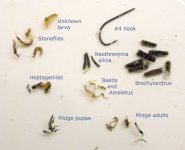afishinado
Moderator
Staff member
Interesting info I recently read on Troutnut. Below is a pic of the stomach contents of a trout. It looked as if it was gorging at a buffet. Many types of insects found in the stomach contents, including a hook!
The lesson is...the vast majority of the time, trout feed on whatever is available (swims or drifts by naturally).
When a heavy hatch occurs, trout may turn selective and just feed on the insect that is most available and is recognized as food, but most times a good presentation with a fly that looks like something good to eat will bring home the bacon.
Here is a link to the thread: http://www.troutnut.com/topic/6630/Stomach-Contents-Eclectic-Feeding-and-Selectivity
with a pic below:
The lesson is...the vast majority of the time, trout feed on whatever is available (swims or drifts by naturally).
When a heavy hatch occurs, trout may turn selective and just feed on the insect that is most available and is recognized as food, but most times a good presentation with a fly that looks like something good to eat will bring home the bacon.
Here is a link to the thread: http://www.troutnut.com/topic/6630/Stomach-Contents-Eclectic-Feeding-and-Selectivity
with a pic below:





